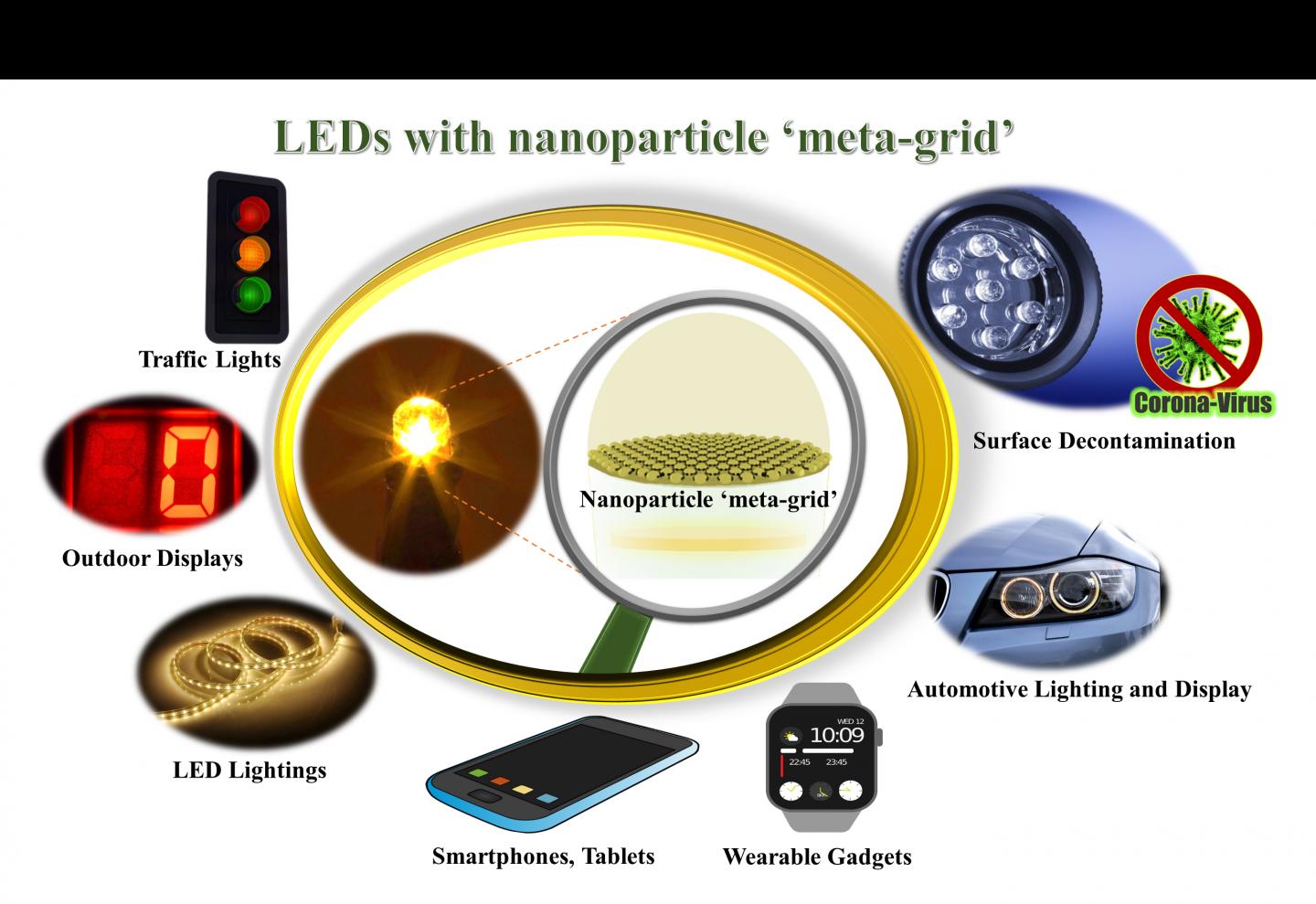Meta-grid of nanoparticles boosts LED performance

Scientists from Imperial College London and the Indian Institute of Technology Guwahati have reported an alternative route for improving light extraction from LEDs
Scientists from Imperial College London and the Indian Institute of Technology Guwahati have reported an alternative route for improving light extraction from LEDs. It proposes increasing transmission of the light generated inside the LED chip across the LED-chip/encapsulant interface by reducing the Fresnel reflection loss at the chip/encapsulant interface within a fixed photon escape cone, while prescribing minimal changes to the manufacturing process.
The enhancement in light transmission is based on destructive interference between light reflected from the chip/epoxy interface and light reflected by the 'meta-grid'. Reducing reflection from the chip/epoxy interface can also increase the lifetime of the LED chip by eliminating heating of the chip from unwanted reflections within the chip.
The team summarised the operational principle and merits of their 'meta-grid' scheme for LED light enhancement below:
"A significant enhancement in light extraction from LEDs can be achieved by boosting the transmission across LED-chip/encapsulant interface, by introducing a monolayer of plasmonic nanoparticles (much smaller than the wavelength of the emitted light) on top of the LED chip which can reduce the Fresnel reflection loss at the chip/encapsulant interface, through enhanced transmission originating from the Fabry-Perot effect. A similar effect is also applicable for enhancing the trapping of light in solar cells", they said.
"Our scheme can be deployed by itself or in combination with other schemes available for increasing the LED efficiency by reducing critical angle losses. The entire original theoretical framework needed for the invention has been developed in-house and is rigorously tested against standard commercial simulation tools. We plan to fabricate a prototype device within one year and corroborate our theoretical predictions with experiments." "Our theoretical model allows determination of the optimal conditions for the structure and properties of the nanoparticle 'meta-grid' layer: viz. the material and composition of nanoparticles, their sizes and average interparticle spacing, and the distance from the surface of the LED chip -- that could provide the maximum enhancement in light extraction from the LED chip into the encapsulating casing, over any emission spectral range of LEDs", they added.
Debabrata Sikdar, from the Indian Institute of Technology Guwahati, said: "With continuous advancement in nanofabrication technology, it is becoming less difficult to fabricate the nanoparticles which are mostly monodisperse and have a very narrow spread. Still, there could always be some randomness in particle size and/or position, flatness of grid, and variation in refractive index due to fabrication error or material defects, which are unavoidable. Effects from most of these inaccuracies can be roughly estimated from our tolerance study and it has shown the robustness of the mechanism of enhanced light extraction".
"There could be different engineering solutions for the meta-grids in the LED-chips. One of them would be to use drying-mediated self-assembly of nanoparticles, e.g. made of silver or alternative less-lossy plasmonic materials capped with appropriate ligands, to form free-standing the Sikdar-Premaratne-Cheng 'plasmene' sheets. Those nanoparticle monolayer sheets could be made stretchable for precise tuning of the interparticle separation and could be stamped on the LED chip before the encapsulating casing is fabricated. The distance of the 'meta-grid' from the LED chip surface can be controlled via the thickness of the plasmene's substrate", Imperial College's Alexei Kornyshev added.
The authors claimed: "In this invention, we have demonstrated the effect of the 'meta-grid' for the standard commercial LEDs, based on group III-V materials. But the proposed concept of enhancing light transmission from an emissive layer to its encapsulant casing can be extended to other types of light emitting devices containing emissive-layer/encapsulant interface. Generally, our idea of using the nanoparticle 'meta-grid' for enhanced light extraction could potentially cater to a wider range of optical gadgets, not just semiconductor LEDs".
"The simplicity of the proposed scheme and the clear physics underpinning it should make it robust and, hopefully, easily adaptable to the existing LED manufacturing process. It is obvious that with larger light extraction efficiency, LEDs will provide greater energy savings as well as longer lifetimes of the devices. This will definitely have a global impact on the versatile LED based applications and their multi-billion-dollar market worldwide", Imperial College's John B. Pendry said.
'Nanoparticle meta-grid for enhanced light extraction from light-emitting devices' by Debabrata Sikdar et al; Light: Science & Applications volume 9, Article number: 122 (2020)


































